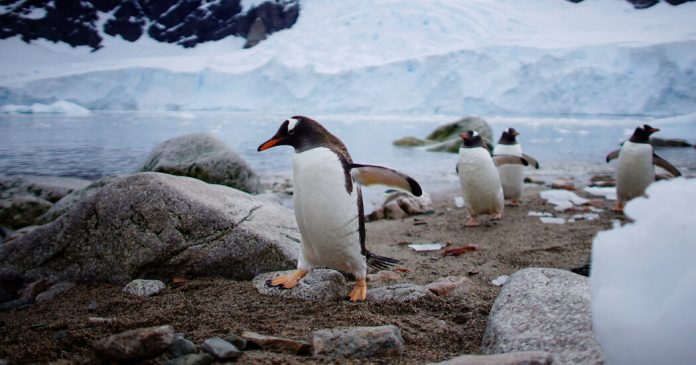Few animals have developed to outlive the unforgiving Antarctic like penguins. Species just like the emperor penguin have overlapping layers of insulating plumage, tightly packed veins to recycle physique warmth and simply sufficient paunch to climate wind chills that strategy minus 80 levels Fahrenheit.
With all these cold-weather variations, it’s troublesome to check penguins residing anyplace else. However fossils of historic penguins have popped up alongside the Equator, and lots of of those prehistoric seabirds predate the formation of Antarctica’s ice sheets. “They lived by means of among the hottest instances in Earth’s historical past, when it was 5 levels hotter on the Equator,” mentioned Daniel Ksepka, a paleontologist on the Bruce Museum in Greenwich, Conn. “They mainly developed in an ice-free context.”
To find out how penguins transitioned from balmy, tropical waters to polar seas, Dr. Ksepka and his colleagues just lately analyzed the genomes of all residing penguins, together with pipsqueaks just like the foot-tall blue penguin, rarities just like the endangered yellow-eyed penguin and showstoppers just like the yellow-tufted rockhopper penguin. Nonetheless, the genetics of contemporary penguins may inform the researchers solely a lot. Most trendy lineages date again solely a pair million years, obscuring many of the 60-million-year odyssey of penguin evolution.
Dr. Ksepka mentioned that greater than three-quarters of all penguin species “are extinct now.” He added, “It’s a must to take a look at the fossil document, otherwise you’re solely getting a fraction of the story.”
To enrich the trendy information, the researchers examined fossils from a motley crew of historic seafarers. Some prehistoric penguins plied tropical waters off Peru, utilizing spearlike payments to harpoon fish. Others sported lengthy legs, and the biggest might have pushed seven ft tall. Some even had patches of rusty pink feathers.
Evaluating the genomes of contemporary penguins with fossil penguins allowed the staff to reconstruct penguin evolution. Of their findings, printed Tuesday in Nature Communications, the researchers pinpointed genes that helped penguins transition from wading by means of heat waters to perfecting the polar plunge. A few of these genes aided penguins’ potential to pack on blubber, whereas others molded their shriveled wings into streamlined flippers. Some even bolstered penguins’ immune programs or helped them tolerate low oxygen throughout deep dives.
The researchers additionally recognized genes that helped fine-tune penguin eyes to see by means of icy depths. Whereas most birds have 4 colour cones of their eyes, one in every of these is inactive in penguins, hampering their potential to see inexperienced and pink. As a substitute, their eyes have tailored to regulate to the ambient blue of the ocean.
Some lacking genes have been perplexing to the researchers. Whereas trendy penguins gobble krill, the staff discovered proof that their ancestors lacked genes that might have helped break down crustacean shells. This can be proof that historic penguins have been spearing bigger prey, like fish and squid. Penguins retain a restricted palate. Their style receptors can choose up solely salty and bitter tastes, which is “fairly good in case you’re consuming fish,” Dr. Ksepka mentioned. “That’s most likely why they’re fairly pleased with sardines.”
When these adjustments occurred in historic penguins, they caught. The genetic analyses revealed that penguins typically have the bottom evolutionary charge of any group of birds. As a result of they give the impression of being so weird, this glacial charge of change appears stunning. However it reveals how profitable the penguin’s plump but streamlined physique plan is — over thousands and thousands of years, it has modified solely in gradual increments. However emperor penguins, which breed throughout the bitter Antarctic winter, have the very best evolutionary charge of any penguin, main the researchers to infer that colder temperatures by some means pace penguin evolution.
Juliana Vianna, an ecologist on the Pontifical Catholic College of Chile, says this concept is in keeping with the southward march of penguins occurring throughout bouts of worldwide cooling. “Their evolutionary historical past is just about related to historic local weather change and glaciation,” mentioned Dr. Vianna, who just lately led related analysis however was not concerned within the new research.
Understanding how penguins modified up to now might provide clues to how these cold-weather specialists may fare in a warmer future. “Warming temperatures will affect the biogeographic ranges of penguins, the species they depend on as meals and the species that, in flip, hunt them,” mentioned Daniel Thomas, a paleontologist from Massey College in New Zealand and an creator of the brand new research.
Whereas the analysis is a complete take a look at the penguin household, Dr. Ksepka mentioned, there’s nonetheless one seabird lacking — the final flying penguin. The small, puffinlike chook most likely lived in historic New Zealand, however its fossils have proved elusive. “That might be the No. 1 factor I’d ask for if I had a genie,” he mentioned.


